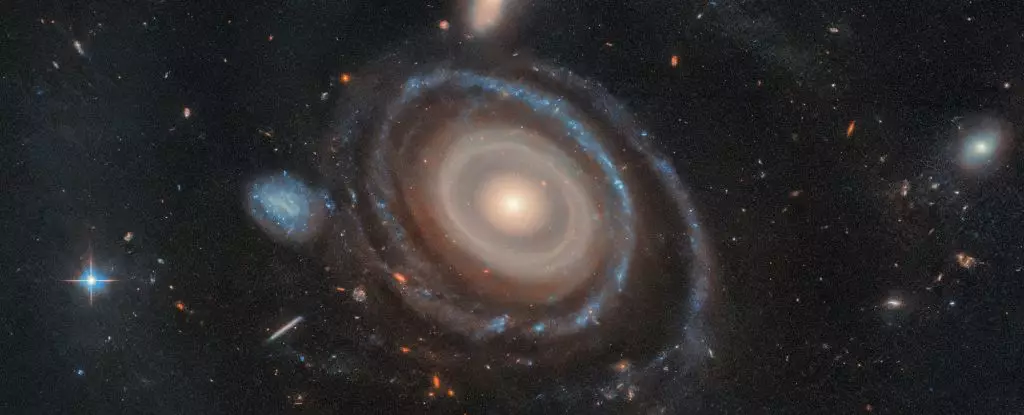In the sprawling universe, where billions of galaxies dance across the cosmic stage, the notion that no two are alike has become an essential tenet of modern astrophysics. The recent discovery of the Bullseye Galaxy, or LEDA 1313424, located an astounding 567 million light-years from Earth, serves as a testament to this principle. This galaxy is not merely another celestial body; it is a resplendent spectacle adorned with nine intricate concentric rings. This extraordinary phenomenon is the result of an intense encounter with a blue dwarf galaxy that passed through its core, sending shockwaves spiraling outward into the depths of space. This discovery has significant implications, offering a glimpse into the intricate web of interactions that govern galaxy formation and evolution.
Ring galaxies are exceptionally rare, their formation resulting from a delicate balance of circumstance and cosmic choreography. When galaxies interact, such encounters often yield a wide array of outcomes, from the graceful merging of two spirals to the chaotic dance of a galaxy piercing another’s heart. The Bullseye Galaxy exemplifies the latter, where the collision’s aftermath has manifested in stunning rings of dust and gas. Renowned astrophysicist Pieter van Dokkum, hailing from Yale University, notes, “We’re catching the Bullseye at a very special moment in time.” The unique qualities of such ring galaxies arise during a fleeting period following their encounters, which ultimately shapes their structure and star-forming potential.
Understanding why ring galaxies form requires a deep dive into the gravitational choreography playing out in our universe. Galaxies exist not in isolation but as part of a complex cosmic web, with gravitational filaments drawing them together. As these colossal entities approach each other, their mutual gravitational influences create intense tidal forces, culminating in spectacular collisions. In the case of the Bullseye Galaxy, one galaxy’s direct passage through the other’s center unleashed rippling shock waves, thus creating a series of rings composed of concentrated galactic material.
This discovery of the Bullseye Galaxy has been made possible largely due to advances in observational technology. Utilizing the Hubble Space Telescope alongside the Keck Cosmic Web Imager (KCWI), astronomers have unraveled the threads connecting the Bullseye to a smaller nearby galaxy, which is just 130,000 kilometers away. As Imad Pasha, a fellow researcher from Yale, explains, the observations reveal a clear connection—an extraordinary tendril of gas flows between the two, confirming their interaction. “The KCWI provided the critical view,” he says, capturing data that illustrates the interaction in a manner previously unseen in astrophysical research.
The implications of this discovery extend far beyond the immediate fascination with ring structures. As van Dokkum indicates, the observations reveal a unique signature of gas transferring between the galaxies, enriching our comprehension of their dynamics. The rings themselves are significantly denser regions resulting from shockwave compression, which subsequently fuels star formation. This mechanism sheds light on how cosmic interactions can lead to vibrant bursts of star birth, leading to visually dazzling rings that glitter with the brilliance of new stars igniting against the backdrop of the cosmos.
Why is the Bullseye Galaxy important to the broader cosmic narrative? Understanding the structures formed during these cataclysmic encounters offers empirical data for existing astrophysical models. The way the rings propagate outward—with consistent spacing mirroring theoretical predictions—allows scientists to refine their understanding of the physical processes governing these magnificent galactic phenomena. It’s akin to dropping a pebble into calm water, where the ripples offer insightful patterns that reveal the dynamics at play.
The Bullseye Galaxy will serve as a reference point for upcoming observational campaigns aiming to uncover more of these complex structures hidden throughout the universe. As astronomical technology continues to evolve, researchers are optimistic about identifying additional ring galaxies, each potentially harboring its own unique story of cosmic collisions and interactions.
The exploration of the Bullseye Galaxy offers not only a visual feast but serves as a remarkable window into the dynamics of astronomical structures. With its unmatched characteristics and the insights gained through cutting-edge observations, this discovery underscores the rich tapestry of interactions that shape our universe. As astronomers peer deeper into the cosmos, they continue to unravel the enigmatic forces at work, deepening our understanding of the grand narrative of cosmic evolution. The Bullseye Galaxy reminds us that even in the vast emptiness of space, extraordinary stories await discovery, illuminating the intricate and often surprising dance of galaxies in the universe.


Leave a Reply